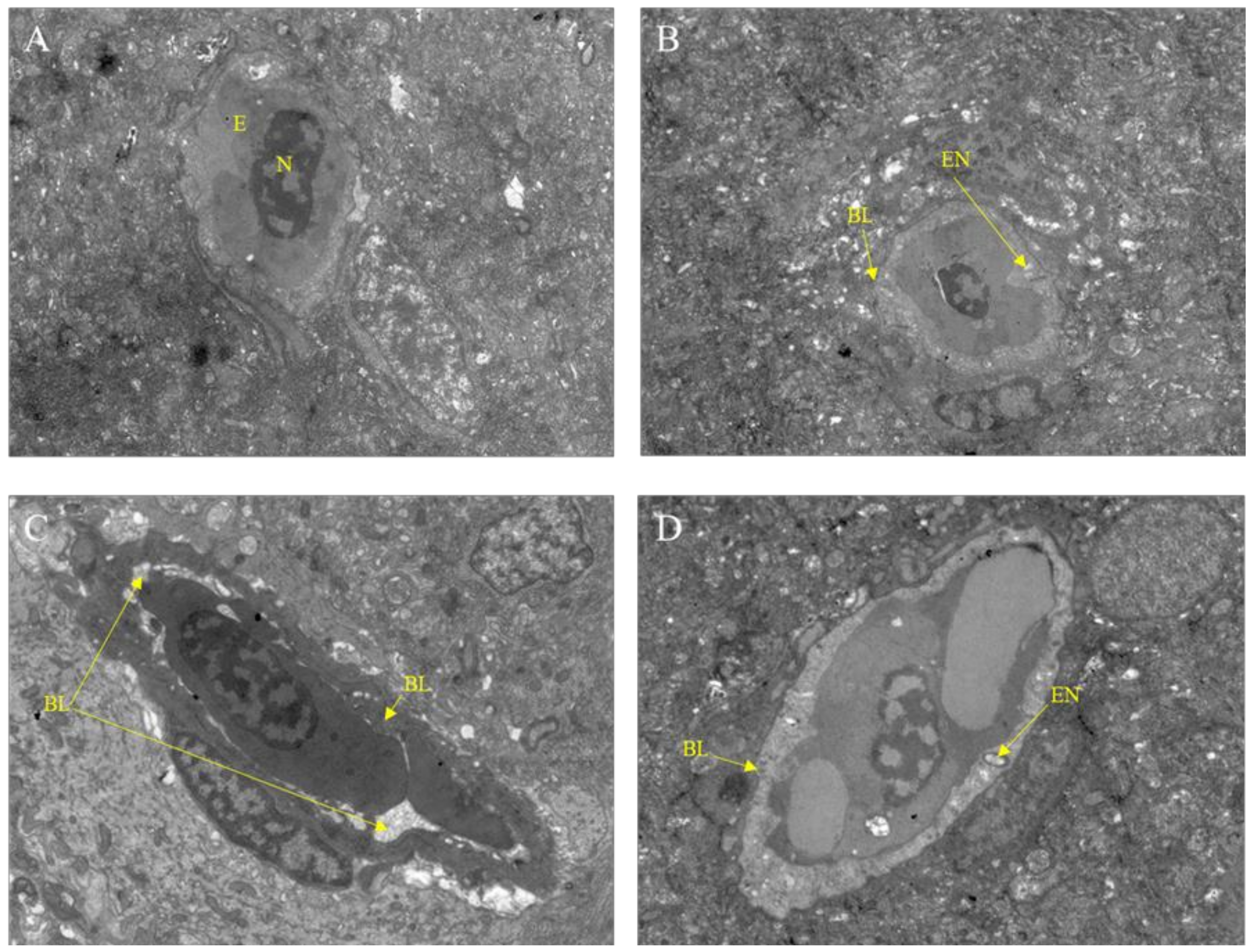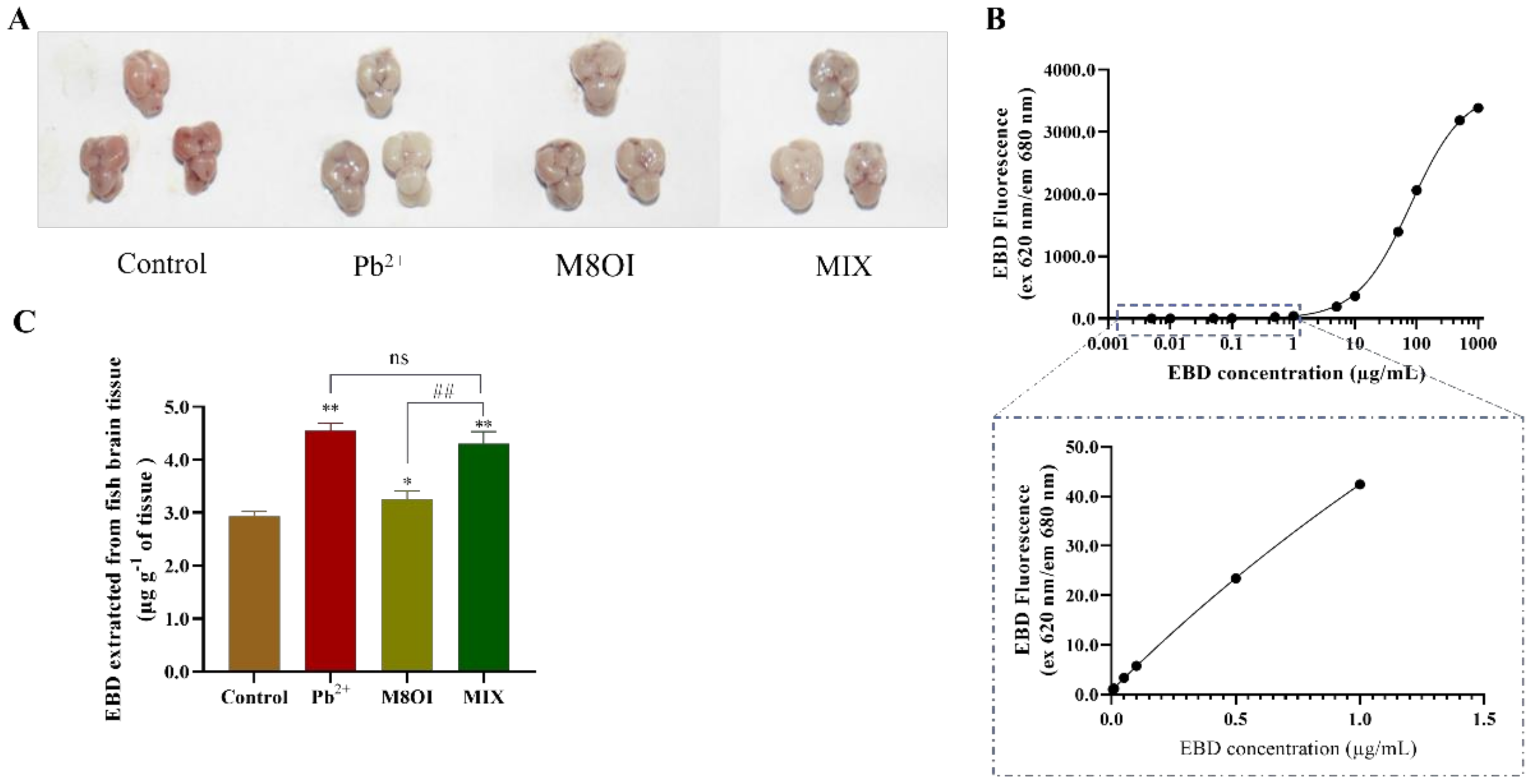Neurotoxicity of Chronic Co-Exposure of Lead and Ionic Liquid in Common Carp: Synergistic or Antagonistic?
Abstract
:1. Introduction
2. Results
2.1. Fish Behavior
2.2. Neurotransmitter Dopamine
2.3. Histopathological Observation
2.4. Transmission Electron Microscope Observation
2.5. Bioaccumulation of Pb in Fish Brain
2.6. BBB Permeability
2.7. Expression of Tight Junction Coding Gene in Blood–Brain Barrier of Fish Brain
3. Discussion
4. Materials and Methods
4.1. Chemical
4.2. Fish
4.3. Exposure and Sampling
4.4. Lead Content in Common Carp Brain
4.5. Behavioral Analysis and Anxiety Identification
4.6. Blood–Brain Barrier (BBB) Integrity Evaluation
4.7. RNA Extraction and Gene Expression Analysis
4.8. Histological Analysis
4.9. Transmission Electron Microscope Analysis
4.10. Neurotransmitter Level Assay
4.11. Data Analysis and Visualization
5. Conclusions
Supplementary Materials
Author Contributions
Funding
Institutional Review Board Statement
Informed Consent Statement
Data Availability Statement
Conflicts of Interest
References
- Shao, Y.; Yan, T.; Wang, K.; Huang, S.; Yuan, W.; Qin, F.G.F. Soil Heavy Metal Lead Pollution and Its Stabilization Remediation Technology. Energy Rep. 2020, 6, 122–127. [Google Scholar] [CrossRef]
- García-Alix, A.; Jimenez-Espejo, F.J.; Lozano, J.A.; Jiménez-Moreno, G.; Martinez-Ruiz, F.; García Sanjuán, L.; Aranda Jiménez, G.; García Alfonso, E.; Ruiz-Puertas, G.; Anderson, R.S. Anthropogenic Impact and Lead Pollution throughout the Holocene in Southern Iberia. Sci. Total Environ. 2013, 449, 451–460. [Google Scholar] [CrossRef] [PubMed]
- Chandio, T.A.; Khan, M.N.; Muhammad, M.T.; Yalcinkaya, O.; Kayis, A.F. Co-Exposure of Neurotoxic Contaminants (Pb and Mn) in Drinking Water of Zhob District, Baluchistan Pakistan. Environ. Nanotechnol. Monit. Manag. 2020, 14, 100328. [Google Scholar] [CrossRef]
- WHO. Incorporating First and Second Addenda. In WHO Guidelines for Drinking-Water Quality, 3rd ed.; WHO: Geneva, Switzerland, 2009. [Google Scholar]
- Kumar, M.; Puri, A. A Review of Permissible Limits of Drinking Water. Indian J. Occup. Environ. Med. 2012, 16, 40–44. [Google Scholar] [CrossRef] [Green Version]
- Gui, D.; Yu, R.Q.; Karczmarski, L.; Ding, Y.; Zhang, H.; Sun, Y.; Zhang, M.; Wu, Y. Spatiotemporal Trends of Heavy Metals in Indo-Pacific Humpback Dolphins (Sousa chinensis) from the Western Pearl River Estuary, China. Environ. Sci. Technol. 2017, 51, 1848–1858. [Google Scholar] [CrossRef]
- Srinivasa Gowd, S.; Govil, P.K. Distribution of Heavy Metals in Surface Water of Ranipet Industrial Area in Tamil Nadu, India. Environ. Monit. Assess. 2008, 136, 197–207. [Google Scholar] [CrossRef]
- Pandiyan, J.; Mahboob, S.; Govindarajan, M.; Al-Ghanim, K.A.; Ahmed, Z.; Al-Mulhm, N.; Jagadheesan, R.; Krishnappa, K. An Assessment of Level of Heavy Metals Pollution in the Water, Sediment and Aquatic Organisms: A Perspective of Tackling Environmental Threats for Food Security. Saudi J. Biol. Sci. 2021, 28, 1218–1225. [Google Scholar] [CrossRef]
- Sheng, Y.; Liu, Y.; Wang, K.; Cizdziel, J.V.; Wu, Y.; Zhou, Y. Ecotoxicological Effects of Micronized Car Tire Wear Particles and Their Heavy Metals on the Earthworm (Eisenia fetida) in Soil. Sci. Total Environ. 2021, 793, 148613. [Google Scholar] [CrossRef]
- Zhu, B.; Wang, Q.; Shi, X.; Guo, Y.; Xu, T.; Zhou, B. Effect of Combined Exposure to Lead and Decabromodiphenyl Ether on Neurodevelopment of Zebrafish Larvae. Chemosphere 2016, 144, 1646–1654. [Google Scholar] [CrossRef]
- Kumar, S.; Moniruzzaman, M.; Chakraborty, A.; Sarbajna, A.; Chakraborty, S.B. Crosstalk between Heat Shock Proteins, NRF2, NF-κB and Different Endogenous Antioxidants during Lead-Induced Hepatotoxicity in Puntius ticto. Aquat. Toxicol. 2021, 233, 105771. [Google Scholar] [CrossRef]
- Mabrouk, A. Thymoquinone Attenuates Lead-Induced Nephropathy in Rats. J. Biochem. Mol. Toxicol. 2019, 33, 6–11. [Google Scholar] [CrossRef] [PubMed] [Green Version]
- Bodeau-Livinec, F.; Glorennec, P.; Cot, M.; Dumas, P.; Durand, S.; Massougbodji, A.; Ayotte, P.; Bot, B. Le Elevated Blood Lead Levels in Infants and Mothers in Benin and Potential Sources of Exposure. Int. J. Environ. Res. Public Health 2016, 13, 316. [Google Scholar] [CrossRef] [PubMed] [Green Version]
- Jones, R.L.; Homa, D.M.; Meyer, P.A.; Brody, D.J.; Caldwell, K.L.; Pirkle, J.L.; Brown, M.J. Trends in Blood Lead Levels and Blood Lead Testing among US Children Aged 1 to 5 Years, 1988–2004. Pediatrics 2009, 123, e376–e385. [Google Scholar] [CrossRef] [PubMed] [Green Version]
- Fewtrell, L.; Kaufmann, R.; Prüssüstün, A.; Prüssüstün, A.; Campbelllendrum, D.; Corvalán, C.; Woodward, A.; Lorna, F.; Fewtrell, L.L.; Kaufmann, R. World Health Organization Protection of the Human Environment Geneva 2003 WHO Library Cataloguing-in-Publication Data; WHO: Geneva, Switzerland, 2013. [Google Scholar]
- Ayuso-Álvarez, A.; Nuñez, O.; Martín-Méndez, I.; Bel-Lán, A.; Tellez-Plaza, M.; Pérez-Gómez, B.; Galán, I.; Fernández-Navarro, P. Metal and Metalloid Levels in Topsoil and Municipal Cardiovascular Mortality in Spain. Environ. Res. 2021, 204, 112395. [Google Scholar] [CrossRef] [PubMed]
- Eiró, L.G.; Ferreira, M.K.M.; Frazão, D.R.; Aragão, W.A.B.; Souza-Rodrigues, R.D.; Fagundes, N.C.F.; Maia, L.C.; Lima, R.R. Lead Exposure and Its Association with Neurological Damage: Systematic Review and Meta-Analysis. Environ. Sci. Pollut. Res. Int. 2021, 28, 37001–37015. [Google Scholar] [CrossRef] [PubMed]
- Yang, L.; Sun, X.; Yang, F.; Zhao, C.; Zhang, L.; Zu, Y. Application of Ionic Liquids in the Microwave-Assisted Extraction of Proanthocyanidins from Larix gmelini Bark. Int. J. Mol. Sci. 2012, 13, 5163–5178. [Google Scholar] [CrossRef] [PubMed] [Green Version]
- Salanti, A.; Zoia, L.; Tolppa, E.L.; Orlandi, M. Chromatographic Detection of Lignin-Carbohydrate Complexes in Annual Plants by Derivatization in Ionic Liquid. Biomacromolecules 2012, 13, 445–454. [Google Scholar] [CrossRef]
- Nikfarjam, N.; Ghomi, M.; Agarwal, T.; Hassanpour, M.; Sharifi, E.; Khorsandi, D.; Ali Khan, M.; Rossi, F.; Rossetti, A.; Nazarzadeh Zare, E.; et al. Antimicrobial Ionic Liquid-Based Materials for Biomedical Applications. Adv. Funct. Mater. 2021, 31, 2104148. [Google Scholar] [CrossRef]
- Klamt, A.; Eckert, F.; Arlt, W. COSMO-RS: An Alternative to Simulation for Calculating Thermodynamic Properties of Liquid Mixtures. Annu. Rev. Chem. Biomol. Eng. 2010, 1, 101–122. [Google Scholar] [CrossRef] [Green Version]
- Yu, M.; Wang, S.; Luo, Y.; Han, Y.; Li, X.; Zhang, B.; Wang, J. Effects of the 1-Alkyl-3-Methylimidazolium Bromide Ionic Liquids on the Antioxidant Defense System of Daphnia Magna. Ecotoxicol. Environ. Saf. 2009, 72, 1798–1804. [Google Scholar] [CrossRef]
- Li, X.Y.; Luo, Y.R.; Yun, M.X.; Wang, J.; Wang, J.J. Effects of 1-Methyl-3-Octylimidazolium Bromide on the Anti-Oxidant System of Earthworm. Chemosphere 2010, 78, 853–858. [Google Scholar] [CrossRef] [PubMed]
- Ma, J.; Li, X.; Cui, M.; Li, W.; Li, X. Negative Impact of the Imidazolium-Based Ionic Liquid [C8mim]Br on Silver Carp (Hypophthalmichthys molitrix): Long-Term and Low-Level Exposure. Chemosphere 2018, 213, 358–367. [Google Scholar] [CrossRef]
- Leitch, A.C.; Abdelghany, T.M.; Probert, P.M.; Dunn, M.P.; Meyer, S.K.; Palmer, J.M.; Cooke, M.P.; Blake, L.I.; Morse, K.; Rosenmai, A.K.; et al. The Toxicity of the Methylimidazolium Ionic Liquids, with a Focus on M8OI and Hepatic Effects. Food Chem. Toxicol. 2020, 136, 111069. [Google Scholar] [CrossRef] [PubMed]
- Probert, P.M.; Leitch, A.C.; Dunn, M.P.; Meyer, S.K.; Palmer, J.M.; Abdelghany, T.M.; Lakey, A.F.; Cooke, M.P.; Talbot, H.; Wills, C.; et al. Identification of a Xenobiotic as a Potential Environmental Trigger in Primary Biliary Cholangitis. J. Hepatol. 2018, 69, 1123–1135. [Google Scholar] [CrossRef] [PubMed] [Green Version]
- Thi, N.H.B.; Thi, N.A.N.; Audira, G.; Siregar, P.; Liang, S.T.; Huang, J.C.; Hsiao, C. Der Chronic Exposure to Low Concentration Lead Chloride-Induced Anxiety and Loss of Aggression and Memory in Zebrafish. Int. J. Mol. Sci. 2020, 21, 1844. [Google Scholar] [CrossRef] [PubMed] [Green Version]
- Chen, J.; Chen, Y.; Liu, W.; Bai, C.; Liu, X.; Liu, K.; Li, R.; Zhu, J.H.; Huang, C. Developmental Lead Acetate Exposure Induces Embryonic Toxicity and Memory Deficit in Adult Zebrafish. Neurotoxicol. Teratol. 2012, 34, 581–586. [Google Scholar] [CrossRef]
- Su, X.; Li, W.; Li, Z.; Liu, K.; Song, M.; Shao, M.; Lv, L.; Chang, X. Chronic Developmental Exposure to Low-Dose ([C8mim][PF6]) Induces Neurotoxicity and Behavioural Abnormalities in Rats. Ecotoxicol. Environ. Saf. 2021, 225, 112806. [Google Scholar] [CrossRef]
- Rajeshkumar, S.; Liu, Y.; Zhang, X.; Ravikumar, B.; Bai, G.; Li, X. Studies on Seasonal Pollution of Heavy Metals in Water, Sediment, Fish and Oyster from the Meiliang Bay of Taihu Lake in China. Chemosphere 2018, 191, 626–638. [Google Scholar] [CrossRef]
- Abreu, M.S.; Giacomini, A.C.V.V.; Koakoski, G.; Piato, A.L.; Barcellos, L.J.G. Evaluating “Anxiety” and Social Behavior in Jundiá (Rhamdia quelen). Physiol. Behav. 2016, 160, 59–65. [Google Scholar] [CrossRef]
- Wang, H.L.; Lai, T.W. Optimization of Evans Blue Quantitation in Limited Rat Tissue Samples. Sci. Rep. 2014, 4, 6588. [Google Scholar] [CrossRef] [Green Version]
- Kinkel, M.D.; Eames, S.C.; Philipson, L.H.; Prince, V.E. Intraperitoneal Injection into Adult Zebrafish. J. Vis. Exp. 2010, 42, 2126. [Google Scholar] [CrossRef] [PubMed]
- Ma, J.; Zhu, J.; Wang, W.; Ruan, P.; Rajeshkumar, S.; Li, X. Biochemical and Molecular Impacts of Glyphosate-Based Herbicide on the Gills of Common Carp. Environ. Pollut. 2019, 252, 1288–1300. [Google Scholar] [CrossRef] [PubMed]
- Wang, H.N.; Li, B.Y.; Chen, F.F.; Zhou, Y.Q.; Li, J.J.; Zheng, X.; Duan, H.Y. Analysis on Phenotype, Catalpol Accumulation and Methylation of Rehmannia glutinosa. Pak. J. Bot. 2019, 51, 461–467. [Google Scholar] [CrossRef]
- Duan, H.; Li, J.; Zhu, Y.; Jia, W.; Wang, H.; Jiang, L.; Zhou, Y. Responsive Changes of DNA Methylation in Wheat (Triticum aestivum) under Water Deficit. Sci. Rep. 2020, 10, 7938. [Google Scholar] [CrossRef] [PubMed]
- Livak, K.J.; Schmittgen, T.D. Analysis of Relative Gene Expression Data Using Real-Time Quantitative PCR and the 2−ΔΔCT Method. Methods 2001, 25, 402–408. [Google Scholar] [CrossRef] [PubMed]
- Shi, Q.; Wang, M.; Shi, F.; Yang, L.; Guo, Y.; Feng, C.; Liu, J.; Zhou, B. Developmental Neurotoxicity of Triphenyl Phosphate in Zebrafish Larvae. Aquat. Toxicol. 2018, 203, 80–87. [Google Scholar] [CrossRef]
- Habibul, N.; Hu, Y.Y.; Hu, Y.; Sheng, G.P. Alkyl chain length affecting uptake of imidazolium based ionic liquids by ryegrass (Lolium perenne L.). J. Hazard. Mate. 2021, 401, 123376. [Google Scholar] [CrossRef]





| Exposure Time (d) | 7 | 14 | 28 | |
|---|---|---|---|---|
| Pb contents (µg g−1 dw) | Control | - | - | - |
| Pb2+ | 16.04 ± 3.16 | 16.47 ± 0.70 | 23.74 ± 2.93 | |
| M8OI | - | - | - | |
| MIX | 9.45 ± 1.38 | 12.96 ± 3.90 | 14.51 ± 1.91 |
Publisher’s Note: MDPI stays neutral with regard to jurisdictional claims in published maps and institutional affiliations. |
© 2022 by the authors. Licensee MDPI, Basel, Switzerland. This article is an open access article distributed under the terms and conditions of the Creative Commons Attribution (CC BY) license (https://creativecommons.org/licenses/by/4.0/).
Share and Cite
Ding, W.; Sultan, Y.; Li, S.; Wen, W.; Zhang, B.; Feng, Y.; Ma, J.; Li, X. Neurotoxicity of Chronic Co-Exposure of Lead and Ionic Liquid in Common Carp: Synergistic or Antagonistic? Int. J. Mol. Sci. 2022, 23, 6282. https://doi.org/10.3390/ijms23116282
Ding W, Sultan Y, Li S, Wen W, Zhang B, Feng Y, Ma J, Li X. Neurotoxicity of Chronic Co-Exposure of Lead and Ionic Liquid in Common Carp: Synergistic or Antagonistic? International Journal of Molecular Sciences. 2022; 23(11):6282. https://doi.org/10.3390/ijms23116282
Chicago/Turabian StyleDing, Weikai, Yousef Sultan, Shumei Li, Wenjun Wen, Bangjun Zhang, Yiyi Feng, Junguo Ma, and Xiaoyu Li. 2022. "Neurotoxicity of Chronic Co-Exposure of Lead and Ionic Liquid in Common Carp: Synergistic or Antagonistic?" International Journal of Molecular Sciences 23, no. 11: 6282. https://doi.org/10.3390/ijms23116282
APA StyleDing, W., Sultan, Y., Li, S., Wen, W., Zhang, B., Feng, Y., Ma, J., & Li, X. (2022). Neurotoxicity of Chronic Co-Exposure of Lead and Ionic Liquid in Common Carp: Synergistic or Antagonistic? International Journal of Molecular Sciences, 23(11), 6282. https://doi.org/10.3390/ijms23116282






